What differentiates your product from the rest of the market? The answer is innovation — i.e. the added value it offers over your competitors. But innovation – and innovation management specifically – is not as easy as it sounds. Not every great idea leads to a great product. A lot of effort goes into making innovation work. Moreover, letting go of traditional practices and adopting technology-driven innovation management approaches can be very challenging.
This is where a little outside perspective comes in very handy. Books for successful innovation managers are available like sand at the sea. That makes it hard to find the ones that really give insights and offer practical tips on how to improve your process and think further ahead.
This is why we hand-picked 10 of our favorite books for successful innovation managers. They introduce you to proven methods for innovation management and serve as inspiration for future projects. So, if you are planning to integrate disruptive technologies into your organization or already managing an innovation team, these 10 books will provide you with insights that make the process a little easier for you.
Explore 10 Books for Successful Innovation Managers
1. The Innovator’s Solution: Creating and Sustaining Successful Growth by Clayton M. Christensen & Michael E. Raynor
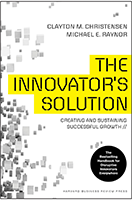 While the next book by the same author iterates the negative effects of ignoring innovation, this one gives a solution to the problem. It cites in-depth research and theories tested in hundreds of companies including bigshots such as Apple, Cisco, Dell, and Microsoft. Evaluating these practical examples, Christensen and Raynor propose valuable guidelines on business decisions critical for becoming the disruptors themselves and achieving growth.
While the next book by the same author iterates the negative effects of ignoring innovation, this one gives a solution to the problem. It cites in-depth research and theories tested in hundreds of companies including bigshots such as Apple, Cisco, Dell, and Microsoft. Evaluating these practical examples, Christensen and Raynor propose valuable guidelines on business decisions critical for becoming the disruptors themselves and achieving growth.
Year Released: 2013
About the authors: Dr. Michael E. Raynor is a director at Deloitte Services LP. In his research and client work, he explores corporate strategy, innovation, and growth across a wide variety of industries.
Review: “Fresh thinking aplenty….nothing less than a handbook for managers who would rather disrupt than be disrupted.” — The Financial Times
Other books they have written:
- The Strategy Paradox (Michael E. Raynor)
- The Innovator’s Manifesto (Michael E. Raynor)
2. The Innovator’s Dilemma: When New Technologies Cause Great Firms to Fail (Management of Innovation and Change) by Clayton M. Christensen
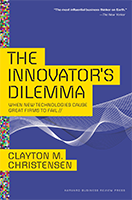 In this classic bestseller, innovation expert Clayton M. Christensen explains how even the most successful companies can lose market leadership despite doing everything right according to their standards. Sticking to traditional business practices often leads to missing out on new disruptive technologies. Compiling both successes and failures from leading companies, this book is a guide that offers a set of rules to leverage new waves of innovation and thrive in the competitive market.
In this classic bestseller, innovation expert Clayton M. Christensen explains how even the most successful companies can lose market leadership despite doing everything right according to their standards. Sticking to traditional business practices often leads to missing out on new disruptive technologies. Compiling both successes and failures from leading companies, this book is a guide that offers a set of rules to leverage new waves of innovation and thrive in the competitive market.
Year Released: 2013
About the author: Clayton M. Christensen was the Kim B. Clark Professor of Business Administration at Harvard Business School. He is the author of eight critically acclaimed books. Christensen also co-founded Innosight, a management consultancy; Rose Park Advisors, an investment firm; and the Innosight Institute, a nonprofit think tank.
Review: “Christensen’s The Innovator’s Dilemma is the foundational read for managing disruptive innovation.” — Steve Blank, Silicon Valley serial-entrepreneur
Other books he has written:
3. Innovation Lab Excellence: Digital Transformation from Within by Richard Turrin
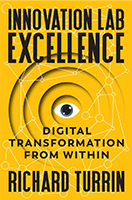 Capitalizing innovation is one of the greatest keys to success but digital transformation within an enterprise is a lot to handle. In this book, FinTech and AI consultant Richard Turrin utilizes his rich experience to pen down the possible challenges organizations face during adopting new technologies and how to tackle them with certain best practices. By discussing the pros and cons of specific approaches in managing an innovation lab, it helps innovation managers evaluate what works for them the best.
Capitalizing innovation is one of the greatest keys to success but digital transformation within an enterprise is a lot to handle. In this book, FinTech and AI consultant Richard Turrin utilizes his rich experience to pen down the possible challenges organizations face during adopting new technologies and how to tackle them with certain best practices. By discussing the pros and cons of specific approaches in managing an innovation lab, it helps innovation managers evaluate what works for them the best.
Year Released: 2019
About the author: Richard Turrin is an award-winning executive previously heading fintech teams at IBM, following a twenty-year career heading trading teams at global investment banks.
Review: “Innovation Lab Excellence dives past the slick surface of espresso machines, youthful techies and creatively designed co-working spaces to examine, in detail, the conditions and practices necessary for a lab and innovation to initiate and thrive.” — Simon Cocking, Chief Editor, Irish Tech News, and Editor In Chief, Crypto Commonwealth
Other books he has written: Cashless: China’s Digital Currency Revolution
4. Innovation to the Core: A Blueprint for Transforming the Way Your Company Innovates by Peter Skarzynski & Rowan Gibson
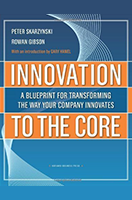 Peter Skarzynski, CEO of Strategos, a consulting firm helping companies with innovation management, and business strategist Rowan Gibson share their accumulated wisdom in the book. Dwelling on the various case studies, it shows how companies can conquer the hurdles that stand in the way of profitable innovation. It addresses crucial topics such as organizing the innovation discovery process, generating strategic insights, expanding the innovation pipeline, and maximizing the return on innovation.
Peter Skarzynski, CEO of Strategos, a consulting firm helping companies with innovation management, and business strategist Rowan Gibson share their accumulated wisdom in the book. Dwelling on the various case studies, it shows how companies can conquer the hurdles that stand in the way of profitable innovation. It addresses crucial topics such as organizing the innovation discovery process, generating strategic insights, expanding the innovation pipeline, and maximizing the return on innovation.
Year Released: 2008
About the authors: Peter Skarzynski is CEO and founding Director of Strategos, a consulting firm he co-founded with Gary Hamel. Rowan Gibson is a global business strategist and editor of the international bestseller Rethinking the Future: Rethinking Business, Principles, Competition, Control & Complexity, Leadership, Markets and the World.
Review: “The good news is that innovation isn’t purely a function of brain wattage and fat research budgets…Innovation lurks within myriad nooks and crannies of any company — from the receptionist to the head of information technology.” — Forbes.com
Other books they have written:
- The Innovator’s Field Guide (Peter Skarzynski)
- On Creativity, Innovation and Renewal (Peter Skarzynski)
- The Four Lenses of Innovation (Rowan Gibson)
5. The Innovator’s Toolkit: 50+ Techniques for Predictable and Sustainable Organic Growth by David Silverstein, Philip Samuel, and Neil DeCarlo
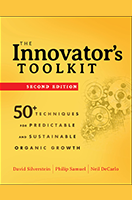 Great ideas alone cannot drive growth organically, an organization requires skillful implementation of a solid innovation management system. This book helps achieve just that by offering more than fifty tools and techniques. Applying these, innovation management teams will be able to identify innovation opportunities, generate new and unusual ideas, select the best ideas for further refinement, and test new solutions for their chances of success in the marketplace.
Great ideas alone cannot drive growth organically, an organization requires skillful implementation of a solid innovation management system. This book helps achieve just that by offering more than fifty tools and techniques. Applying these, innovation management teams will be able to identify innovation opportunities, generate new and unusual ideas, select the best ideas for further refinement, and test new solutions for their chances of success in the marketplace.
Year Released: 2012
About the authors: David Silverstein is the founder of BMGI, an international firm specializing in innovation, performance improvement, and strategy. He has been featured in the Wall Street Journal, Worth magazine, Investor’s Business Daily, and Forbes.com. Dr. Philip Samuel is the Chief Innovation Officer of BMGI. Being a thought leader in the field of strategy and innovation, he is a trusted advisor for executives in a variety of industries. Neil DeCarlo is a veteran author, editor, and publishing coach who has partnered with firms such as BMGI and McKinsey & Company.
Review: “This is a well-written, confident and comprehensive volume that should form part of any forward-thinking business leader′s library.” — Quality World Magazine
Other books they have written:
- Design for Lean Six Sigma: A Holistic Approach to Design and Innovation (Philip Samuel)
- Six Sigma For Dummies (Neil DeCarlo)
6. Ten Types of Innovation: The Discipline of Building Breakthroughs by Larry Keeley, Helen Walters, Ryan Pikkel, and Brian Quinn
 Using a list of more than 2,000 successful innovations, including Cirque du Soleil, early IBM mainframes, the Ford Model-T, among others, the book applies a proprietary algorithm and determines ten types of innovation. It lets innovation managers identify patterns of innovation within industries, recognize innovation opportunities, and evaluate how their organization is performing against competitors.
Using a list of more than 2,000 successful innovations, including Cirque du Soleil, early IBM mainframes, the Ford Model-T, among others, the book applies a proprietary algorithm and determines ten types of innovation. It lets innovation managers identify patterns of innovation within industries, recognize innovation opportunities, and evaluate how their organization is performing against competitors.
Year Released: 2013
About the authors: Larry Keeley is the President and co-founder of Doblin Inc (now a unit of Deloitte Consulting), an innovation strategy. Brian Quinn leads client relationships and programs at Doblin. He partners with senior executives to help their organizations innovate and become better innovators. Ryan Pikkel is a design strategist at Doblin. He is responsible for guiding clients and teams through innovation programs. Helen Walters is the former editor of innovation and design at Bloomberg Businessweek. She now works as a writer, editor, and researcher at Doblin.
Review: “Ten Types of Innovation will become the indispensable ‘how to do it’ textbook of disruptive innovation, providing an executable roadmap for transformative change in any industry.” — Dr. Nicholas F. LaRusso, Medical Director, Mayo Clinic Center for Innovation
7. Harvard Business Essentials: Guide to Managing Creativity and Innovation (Compiler)
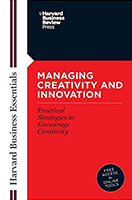 Innovation is the catalyst for company growth. But often managers fail to create an environment that encourages and rewards creativity. This, in turn, blocks innovation. The book from the Harvard Business Essential series explores a manager’s role in inspiring creativity within the team. It provides insights on how a leader can create an innovation-friendly culture, leading to the generation of new ideas, brainstorming conflicts within groups, and recognizing opportunities for growth and success.
Innovation is the catalyst for company growth. But often managers fail to create an environment that encourages and rewards creativity. This, in turn, blocks innovation. The book from the Harvard Business Essential series explores a manager’s role in inspiring creativity within the team. It provides insights on how a leader can create an innovation-friendly culture, leading to the generation of new ideas, brainstorming conflicts within groups, and recognizing opportunities for growth and success.
Year Released: 2011
Other books in the series:
8. The Oxford Handbook of Innovation Management by Mark Dodgson, David M. Gunn, and Nelson Phillips
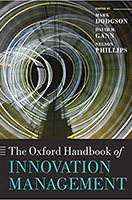 Proper management is essential for innovation to succeed. With contributions from 49 world-leading scholars, the handbook explores the sources of innovation, and the social, economic, and technological factors encouraging as well as constraining it. It addresses the traditional concerns of innovation management such as managing Research & Development (R&D), Intellectual Property, and creativity. Each chapter identifies key issues and reviews the most important research findings.
Proper management is essential for innovation to succeed. With contributions from 49 world-leading scholars, the handbook explores the sources of innovation, and the social, economic, and technological factors encouraging as well as constraining it. It addresses the traditional concerns of innovation management such as managing Research & Development (R&D), Intellectual Property, and creativity. Each chapter identifies key issues and reviews the most important research findings.
Year Released: 2015
About the authors: Mark Dodgson is Professor and Director of the Technology and Innovation Management Centre at the University of Queensland Business School. David M. Gann is Professor of Technology and Innovation Management and Vice President, Development and Innovation, Imperial College London. He has co-founded four start-up ventures. Nelson Phillips is Professor of Strategy and Organizational Behaviour at Imperial College Business School in London, UK. His research interests include institutional theory, organizational discourse analysis, the impact of technology on organizations, and the management of innovation.
Other books they have written:
- The Management of Technological Innovation (Mark Dodgson and David Gann)
- Think, Play, Do: Innovation, Technology, and Organization (Mark Dodgson and David Gann)
- Technology and Organization: Essays in Honour of Joan Woodward (Nelson Phillips)
9. The A to Z of Innovation Management: Essential Guide to 26 Key Innovation Management Theories, Models & Frameworks by Dr. Mike Kennard
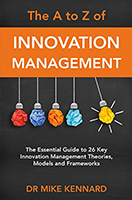 Effective innovation management is imperative for retaining existing customers and gaining new ones. This book helps busy professionals stay abreast of the new developments in the field of innovation. It narrates 26 key Innovation Management theories, models, and frameworks incorporating strategic, organizational, economic, and technological perspectives. This provides the managers with the knowledge, insights, and tools needed to avoid the pitfalls, overcome the difficulties, and finally achieve success.
Effective innovation management is imperative for retaining existing customers and gaining new ones. This book helps busy professionals stay abreast of the new developments in the field of innovation. It narrates 26 key Innovation Management theories, models, and frameworks incorporating strategic, organizational, economic, and technological perspectives. This provides the managers with the knowledge, insights, and tools needed to avoid the pitfalls, overcome the difficulties, and finally achieve success.
Year Released: 2018
About the author: Dr. Mike Kennard is a Programme Director and Senior Lecturer in Strategy and Innovation at Birmingham Business School.
10. Innovation Management and New Product Development by Paul Trott
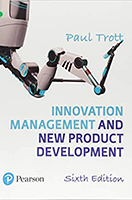 Professor of Innovation Management, Paul Trott, in his book, simplifies various business models for change management and user-driven innovation through product development. The case studies on 3M, eBay, PayPal, and Gore-Tex®, provide an evidence-based approach to managing innovation in a wide range of contexts, including manufacturing, services, as well as small to large organizations.
Professor of Innovation Management, Paul Trott, in his book, simplifies various business models for change management and user-driven innovation through product development. The case studies on 3M, eBay, PayPal, and Gore-Tex®, provide an evidence-based approach to managing innovation in a wide range of contexts, including manufacturing, services, as well as small to large organizations.
Year Released: 2016
About the author: Paul Trott is Professor of Innovation Management at the Business School, University of Portsmouth, and Professor of Innovation Management & Entrepreneurship at The Technical University of Delft.
Review: “Trott adopts a refreshing multi-functional perspective to innovation management and new product development. The structure and content of the third edition are carefully crafted to present NPD as a real management process, with associated challenges and dilemmas clearly highlighted. My MBA and final year undergraduate students find the book accessible and very readable. It provides valuable support to their learning.” — Dr. Helen Perks, Chairperson, Product Development and Management Association (PDMA) UK and Ireland
Other books he has written:
What are your top books for successful innovation managers? Get in touch & let us know!
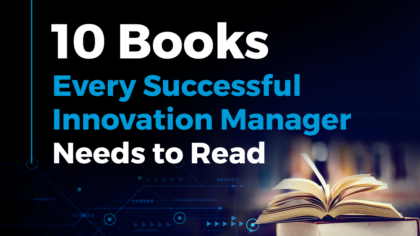
![AI Implementation | A Comprehensive Strategic Guide for Enterprises [2025-2030]](https://www.startus-insights.com/wp-content/uploads/2025/04/AI-Implementation-SharedImg-StartUs-Insights-noresize-420x236.webp)
![AI in Agriculture: A Strategic Guide for Industry Leaders [2025-2030]](https://www.startus-insights.com/wp-content/uploads/2025/03/AI-in-Agriculture-SharedImg-StartUs-Insights-noresize-420x236.webp)
![AI in Automotive: A Strategic Guide for Industry Leaders [2025-2030]](https://www.startus-insights.com/wp-content/uploads/2025/03/AI-in-Automotive-SharedImg-StartUs-Insights-noresize-420x236.webp)




